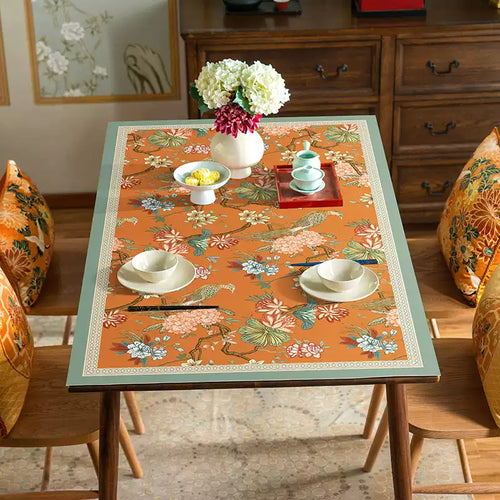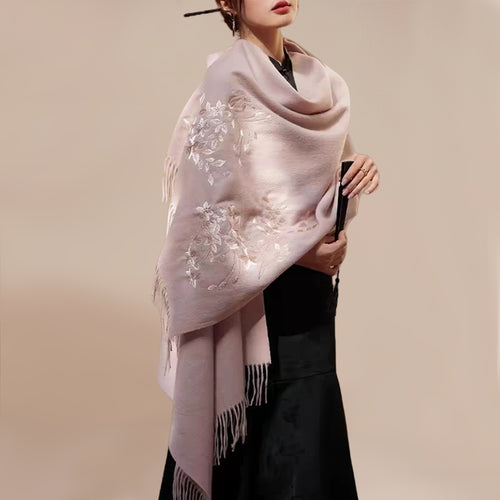Guangdong (Canton), a bustling port city located on the southern coast of China, has long been a hub for trade and cultural exchange. Beyond its expansive markets and bustling docks, Guangzhou is also home to a fascinating art form - Canton Embroidery. This traditional embroidery is characterized by vibrant colors and intricate details. As an intangible cultural heritage, decorative art, and export commodity, Canton Embroidery has not only captured the hearts of Chinese people but also garnered international acclaim.
So, what is Canton Embroidery exactly? How does it differ from other embroidery styles? This article will take you on a journey through time and space, exploring its ancient origins and experiencing its unique craftsmanship. Let us embark together to appreciate the splendor of Canton Embroidery and explore all that interests you.
What is Canton Embroidery
Canton Embroidery, also know as Guangzhou Embroidery, is a general term for traditional embroidery crafts in Guangdong Province, China, including the cities and counties of Guangzhou, Foshan, Shunde, and Nanhai. Together with Chaozhou embroidery (from the Chaoshan region of Guangdong), it is collectively known as Yue Embroidery, and is one of the four famous sinocultural embroideries.
Renowned for its rich compositions, vivid images, clear texture, rich colors, diverse stitches, and skillful variation, Canton Embroidery boasts distinct artistic features. Its history is very long, dating back to the Tang Dynasty (equivalent to the Middle Ages) more than 1000 years ago. In 2006, Canton Embroidery was approved and included in the first batch of China's national intangible cultural heritage list.

What is History of Canton Embroidery
The earliest record of Canton Embroidery can be found in the Miscellaneous Compilation of Duyang (《杜阳杂编》) from the Tang Dynasty. It documented a 14-year-old girl named Meiniang Lu who was "extremely skilled, able to embroider seven scrolls of the Lotus Sutra on a foot-long piece of silk." By the Song Dynasty, Contan Embroidery had become increasingly mature. Ming Dynasty also witnessed Canton Embroidery become one of the important folk handicrafts.
In 1514 (during the Ming Dynasty), a Portuguese merchant bought a dragon robe embroidery piece in Guangzhou and presented it to his king, receiving a great reward. Canton Embroidery spread its reputation to Europe from then on. Queen Elizabeth I of England personally advocated for the establishment of the British Embroidery Guild, importing silk and threads from China to produce noble attire. King Charles I also mobilized the people to plant mulberry trees and raise silkworms. At that time, Canton Embroidery was praised by scholars as "China's gift to the West", and museums in England, France, Germany, and the United States all have its collections.
During the Qing Dynasty (1636-1912), there were countless embroidery workshops in Guangzhou, with the workforce reaching thousands. After the overthrow of the feudal monarchy, Canton Embroidery saw the rise of professional specialization, giving birth to a generation of master craftsmen. Yu De's embroidered piece won first prize at the Panama-Pacific International Exposition held in San Francisco, USA. After that, he was praised as "Embroidery King" within the industry. In 1922, his other work won the second prize at the opening ceremony of the London Bridge in the UK. To this day, Canton Embroidery remains active internationally and is sold as an export commodity to various countries.

Top Characteristics of Canton Embroidery
Compared with Suzhou Embroidery, Sichuan Embroidery, and Hunan Embroidery, which are also known as the four famous embroideries in China, Canton Embroidery has its own unique style. It boasts a wide range of themes, rich colors, versatile stitching techniques, and places a greater emphasis on the artistic effect of the embroidered pieces. To truly hold its uniqueness, you can appreciate it from the following three aspects.
Materials
The main materials used in Canton Embroidery include cotton, linen, wool, silk, synthetic fabrics, and colored beads. Among these, silk is one of the most commonly used due to its high luster and smooth texture, which can well express the details of Canton Embroidery. Gold thread and silver thread are also commonly used. They can make products more gorgeous and noble. In addition, there are a variety of embroidery threads available, such as plush thread, nylon thread, hair, horsetail, and peacock feathers. All these can add different textures and colors to Guangzhou embroidery.

Motifs
Canton Embroidery boasts a rich motifs, primarily including animals, plants, figures, and landscapes. Among them, the most representative subjects are flowers, birds, insects, and fish, often used to express best wishes and good fortune. Meanwhile, Canton Embroidery often depicts historical stories and legends, such as A Dream in Red Mansions and Romance of the Three Kingdoms. Overall, Canton embroidery cover a wide range of cultural elements and social life, reflecting the profound cultural heritage of the Chinese nation.

Craftsmanship
The craftsmanship of Guangzhou embroidery is very complicated, and it takes many steps to complete a fine piece of work. Firstly, various colors of silk threads and embroidery fabric need to be prepared. Then, the design is embroidered onto the fabric according to the pattern. This process requires the use of many different stitches, such as crochet, straight stitch, edge stitch, and other 30 stitch techniques. Beyond that, attention must also be paid to color coordination and the thickness of the threads to ensure the quality and beauty of the embroidery. you need to do some finishing and trimming work to make the embroidery more perfect.
Modern Applications and Trends of Canton Embroidery
As a folk embroidery art, Canton Embroidery was mainly used for home decoration and the production of daily clothing as a symbol of status and status in the past. With the changing times, it has become more accessible to ordinary people and gradually applied in various occasions, such as:
● Interior Decoration: Canton Embroidery can be used to make various interior decoration products, such as curtains, tablecloths, carpets, and tapestries, adding a cultural ambiance and artistic flair to the room;
● Gift Giving: Canton Embroidery can also be given as a gift to friends and relatives to express blessings and gratitude;
● Fashion Design: With its exquisite patterns and unique style, Canton Embroidery is increasingly favored by designers and applied in fashion design and accessory production;
● Art collection: Canton Embroidery has a high collection value. Some exquisite embroidery works can be sold at high prices;
● International Exchange: As a Chinese boutique, Guangzhou embroidery can promote Chinese culture and traditional handicrafts through exhibitions and trade. This helps different culture corporate and innovate.
The opening up and exchanges of the world have broadened the application scope of Canton Embroidery, and its development trend is also becoming more diversified and innovative. Only by continuously adapting to the changes and needs of the times, and introducing digital technology and international trade into Canton Embroidery can its vitality and life force be maintained.
Final Words
Canton embroidery beautifully weaves together history, culture, and craftsmanship into its designs. From its origins to its modern applications, this art form continues to captivate with its exquisite beauty and attention to detail. If you appreciate this sinocultural artistry and skill, consider showing your support. A simple click will go a long way in promoting this cherished tradition for generations to come.











































